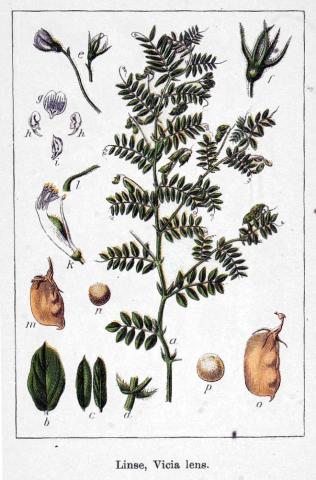Lens culinaris

| Common Name | Cultivated Lentil
|
|---|---|
| Genus | Lens
|
| Species | culinaris
|
| Ploidy | Diploid
|
| Chromosome Number | 2n = 14
|
| Genome Size | ~4 Gbp
|
| Taxonomy | cellular organisms; Eukaryota; Viridiplantae; Streptophyta; Streptophytina; Embryophyta; Tracheophyta; Euphyllophyta; Spermatophyta; Magnoliophyta; Mesangiospermae; eudicotyledons; Gunneridae; Pentapetalae; rosids; fabids; Fabales; Fabaceae; Papilionoideae; Fabeae; Lens
|
Lentil (Lens culinaris Medik.) is an important pulse crop with annual production of 3-4 Mt across 70 countries (Cubero et al. 2009. DOI 10.1079/9781845934873.0000; pg. 13). Lentils are a good source of protein, carbohydrates, micronutrients and vitamins for human nutrition and is consumed in more than 120 countries. Furthermore, their small seed size and flat shape make them relatively quick cooking and easily decorticated compared to most other grain legumes (Sharpe et al. 2013. BMC Genomics. DOI 10.1186/1471-2164-14-192). The Lentil plant has a bushy growth habit with a height of about 40 cm; the seeds are lens-shaped and usually grow two per pod.
Nutrition
Lentils offer many health benefits for human nutrition since they are high in fibre, protein, complex carbohydrate and low in calories and fat. The high level of soluble fiber and complex carbohydrates found in lentils can help people stabilize blood sugar levels. The high protein content can help people who want to boost their protein intake. Using lentils to replace meat can reduce saturated fat intake while supplying important nutrients for your daily diet since lentils are an excellent source of potassium, folate, iron, mangansese and other minerals. Also, they are naturally gluten-free can help people who are gluten intolerant. Therefore, lentils can be your perfect choice if you are looking for healthy food options.
Morphology
Lens culinaris (cultivated lentil) is generally between 20 and 30 cm tall, but some cultivars can grow as tall as 75 cm and as short as 15 cm. Lentil is indeterminate which means growth habits of lentil can be considerable different: erect to semi-erect and compact growth to branched low bushy forms. Other morphological features, like number of leaflets, flower colour, seed size, cotyledon colour and days to maturity also exhibit a wide range of variations. The variations are mainly determined by genotypes but can be fairly affected by environmental conditions.
-
 Albert (Bert) Vandenberg, Emeritus Breeder:
Breeding lentil varieties and conducting related research in collaboration with colleagues.
Albert (Bert) Vandenberg, Emeritus Breeder:
Breeding lentil varieties and conducting related research in collaboration with colleagues.
-
 Kirstin E. Bett: Breeding lentil and dry (common) bean varieties and conducting related research in collaboration with colleagues.
Kirstin E. Bett: Breeding lentil and dry (common) bean varieties and conducting related research in collaboration with colleagues.
-
 Ana Vargas: Lead lentil and faba bean breeding program at the Crop Development Centre in USask's College of Agriculture and Bioresources.
Ana Vargas: Lead lentil and faba bean breeding program at the Crop Development Centre in USask's College of Agriculture and Bioresources.
JBrowse: CDC Redberry Genome Assembly 2.0 (Lcu.2RBY)
The genome for this JBrowse was constructed using long-reads combined with HiC, an optical and genetic map, to yield 3.69 Gb of sequence and 58,243 genes. Please refer to the assembly page for a citation of this genome.
